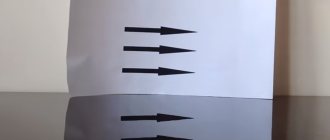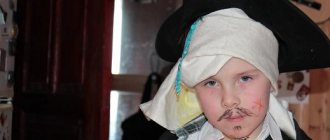Snowman made from a sock
A great option for overly busy parents. By spending just a little time, you and your child can make a beautiful winter craft from scrap materials.
To do this you need:
- cut off the top of the sock to the heel (preferably white) and make a bag, gathering it into a bun and tying it tightly on one side;
- fill the bag with soft material, for example, padding polyester, and separate the body from the head, tying the snowman in the right place with thread. You can make a snowman more stable if you use any small grain as a filler;
- The snowman's hat and scarf can be made from paper or colored fabric, and the nose, eyes and mouth can be made from multi-colored beads.
The cheerful snowman for kindergarten is ready. To complete the look, you can sew colored buttons to the body.
Creating a diagram of the future building
There are two ways to create the walls of a future building. For the first, a scheme like the one in the photo below is used. This is literally the entire building, but in a centerfold. Adjacent walls can be made continuous and not cut. They will simply need to be bent later, forming the corners of the building.
Immediately mark the locations of future windows. They must be on the same level. Don't forget to leave small indentations on the sides and bottom of the walls, as in the diagram. Afterwards, with their help it will be possible to connect the structural parts with each other. The entire building should be done to scale so that later the walls, roof and other parts of the house are proportional.
About company
Top 3D Shop is one of the largest Russian companies selling high-tech equipment for 3D printing, 3D scanning, CNC machines and industrial robots.
Comprehensive customer service and a wide range of additional services have allowed the company to become one of the leading players in this market. Read about the history of Top 3D Shop in the article “How I built a successful 3D printing business.”
Our clients include companies such as:
| European Parliament | Moscow Aviation Institute | Novo Nordisk | Skolkovo | Gazpromneft-Development |
Opinion of Top 3D Shop specialists
The main task in 3D modeling of any children's institutions is to clearly show architects and clients the peculiarities of perception of the design of the building and internal spaces by both adults and children. The layout should also be able to quickly make changes to the project, since the main modern trend in the construction of such objects is to emphasize the concept of individuality and organically fit the structure into the surrounding space.
You can read more about the technologies used to create layouts in the article “Making a layout of a school of any complexity.”
Making a layout: method 1
After the entire diagram is drawn on paper, all that remains is to cut out the future building, bend the lines marked with a blue dotted line and cut the windows with a construction knife. Use a modeling board. It allows you to cut out parts from cardboard and then glue them together much more conveniently. The scheme presented in the photo above is suitable for the production of the simplest houses. A more complex structure will literally have to be made up of several parts. By the way, the layout can also be made to open (so you can see the interior of the house). It is on this principle that children's doll houses are made, which can be purchased in the store.
To make such a layout (photo), it is advisable to use the thickest cardboard you can find. In order for part of the wall to open, an appropriate fastener is used (this can be found in old Soviet-made boxes) or simply a piece of cardboard bent in half. Doors can be made to open in the same way.
Practical examples
Bilingual Kindergarten of East China Normal University, Antiing City, China
Task
Source: arch2o.com
Antin is a modern suburb located between northwestern Shanghai and Suzhou Huaqiao. The kindergarten, located in a new residential area south of the Antin metro station on line 11, is one of the first objects of the complex.
The modern concept of Chinese urban planning - the unity of society and nature - also and primarily concerns educational institutions, and is to enable children to perceive and learn about the world, while absorbing and preserving folk traditions.
The Scenic Architecture Office company had a task: to place it on a small site of 7400 sq.m. a kindergarten for 15 children's groups, combining modern principles with traditional ones.
Solution
Source: arch2o.com
The courtyard in Chinese architecture is not only a tradition of physical space, but also the core of emotion and communication. This helps people maintain family cohesion and strengthen connections with friends and relatives. But this legacy today is a pipe dream for most citizens.
To evaluate possible architectural solutions to this problem, a 3D model of the new kindergarten was printed.
Source: arch2o.com
Kindergartens need fencing in their yards. Following the sloping western boundary of the site, hexagonal plots of regular and irregular shapes, modified to suit the landscape, were designed to pave the area to receive maximum sunlight from the west, south and east. The honeycomb composition better suits the sloping border while eliminating the restrictive traditional symmetry.
Source: arch2o.com
The end result was an unfinished hexagon for the courtyard. Three of the six sides were designed identically, for a more flexible combination of sunlight needs and functionality.
Source: arch2o.com
Entering the gate, children and teachers find themselves in a courtyard with flowers and herbs on different levels, move in zigzag corridors along the edges of the hexagon, pass through lobbies and common spaces, and walk past different classrooms along diverging and merging paths.
Source: arch2o.com
Each two classrooms have a common exit to the courtyard and direct access from the street. After passing through the courtyard, children can resume their journey to other areas including the library, music room, art room, cafeteria, multi-purpose room, small farm and other classrooms.
Source: arch2o.com
Collective classroom activities take place around a column in the center of the room, while teams or individual children can use raised spaces along windows and walls to read, write or care for their small plants.
Kindergarten in Copenhagen, Denmark, Cobe company
Task
Source: cobe.dk
The city of Copenhagen commissioned the architectural company Cobe to design a kindergarten for 160 children under 6 years old with an area of 1950 m². The building needed to be located in the heart of a vibrant historical district. In this lush green garden village, among beautiful red brick houses, Forfatterhuset was to be built - a kindergarten organized around large mature trees, like houseplants on a terrace.
Solution
Source: cobe.dk
Conceptual model showing how the facade surrounds the buildings and existing trees on the site. De Gamles By is a green oasis in the city. The area consists of red brick buildings set on a lush carpet of green. One of the conditions was to create a functional and comfortable building without disturbing the appearance of the area.
Source: cobe.dk
As well as being a community for seniors, it is already home to five nursery schools, vegetable gardens for a nearby public school, open space for a high school and a petting zoo.
Source: cobe.dk
The green area is divided into large and small garden areas, lively play areas, roof terraces and quiet alcoves. Forfatterhuset is both a playground and a building, a park and an institution. This is a whole children's world that needs to be discovered and explored.
Source: cobe.dk
The heart of the kindergarten is a vertical, bright space.
Source: cobe.dk
“This is a subtle art, adding new to old in a historic area. First and foremost, we wanted to understand the characteristics of the area, highlight them, but at the same time create something new and contrasting,” says Dan Stubbergaard, architect and founder of Cobe.
The project was shortlisted for the Mies van der Rohe 2015 award and became a finalist for the Architizer A+ 2015 award.
Making a layout for a house model with your own hands
The process of making reamers yourself is no less exciting than working with ready-made samples. To do this, you will need almost any program for working with graphic images installed on your computer. CorelDraw or something similar that processes vector images is best. In it, with an increase or decrease in the image size, both the thickness of the lines and the loaded textures change in the same ratio. This allows you to obtain more realistic images. And the library of textures built into its shell is impressive. At the same time, by filling the sweep element with texture, you can get the finished appearance of the main layout elements.
The entire process, including filling parts of the scan with the selected texture, applying visual effects and architectural elements, and inserting images from the symbol library, takes from 10 minutes to half an hour if the house is not very complex. Print the scan on a color printer and start prototyping.
For testing, you can also use this one we made by copying the image to your computer and enlarging it to the required size.
Simple house layouts without development
These are, first of all, houses assembled with your own hands from paper cylinders. The same layouts are great for various small architectural forms on prefabricated layouts with landscapes.
But also, using a similar technique, you can create a realistic model that imitates a log house so dear to the heart of any Russian.
To do this, you need to take longer pieces of paper to make the tubes, so that after folding, its turns resemble the annual rings of a tree cut.
And the junctions of the crowns can be modeled by pressing the ends of the tubes with a solid round object of suitable diameter.
It is easy to assemble a paper frame from such elements. And display the intermediate crowns along the facades, and for a sample you can take a photograph of any real log house.
It is better to make roof coverings for model houses separately, in the form of paper slate sheets, tile flakes or honeycombs of bitumen shingles.
Dear readers, if you have any questions, please ask them using the form below. We will be glad to communicate with you



